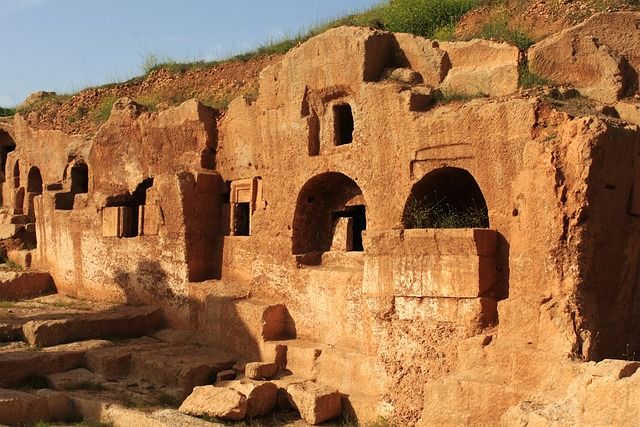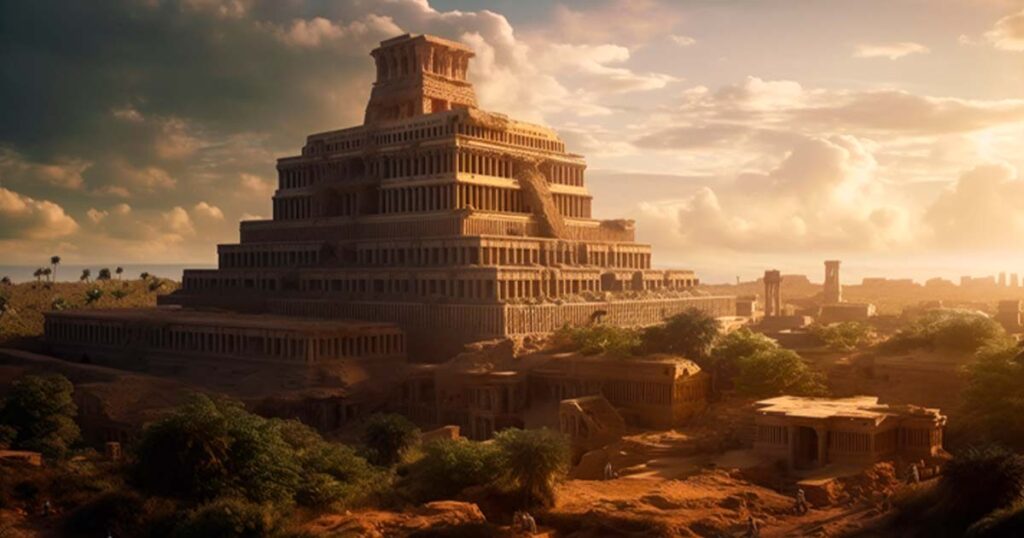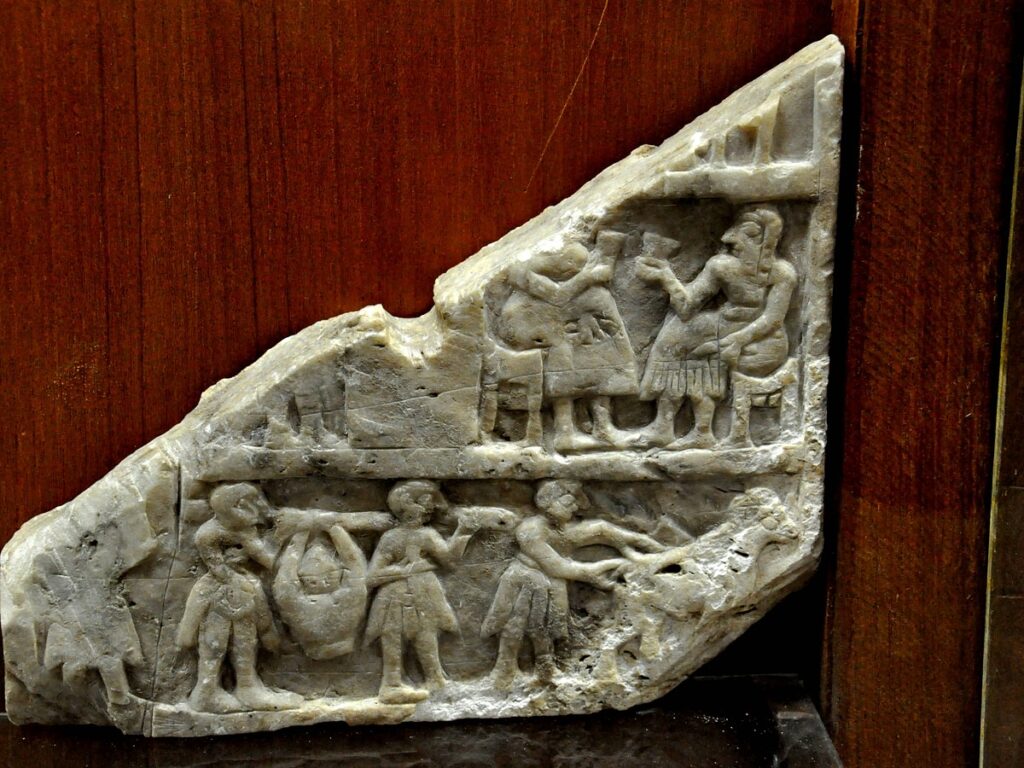Mesopotamia, often hailed as the cradle of civilization, unveils a tapestry woven with architectural marvels that stand as testaments to human ingenuity and advancement. Embarking on a journey through time, one encounters the awe-inspiring structures that defined the landscapes of ancient Mesopotamia. These architectural wonders, built by Sumerians, Akkadians, Babylonians, and Assyrians, not only served practical purposes but also reflected the profound cultural and societal dimensions of their civilizations.
If you are traveling to Iraq to see ancient ruins of Mesopotamia you can install bus bars in your car to elevate your car audio experience!
Mesopotamian architecture emerges as a blend of artistic brilliance and functional pragmatism. Cities like Ur and Uruk showcase ziggurats that pierce the sky, invoking a connection between the earthly and the divine. These colossal structures, dedicated to deities, served as religious centers, fostering a spiritual ambiance that resonated throughout the region. The ziggurats, with their intricate designs and colossal scale, exemplify the Mesopotamian commitment to building structures that transcended the mundane.
Many ancient appliances are discovered by archaeologists and they work with a company that provides appliance repair in Charlotte NC to restore them.
Engineering Ingenuity: Irrigation and Fortifications

Beyond the grandeur of religious edifices, Mesopotamia’s architectural prowess extended to practical domains, leaving an indelible mark on the annals of engineering history. The intricate system of irrigation canals, exemplified by the Hanging Gardens of Babylon, transformed arid landscapes into flourishing oases. This feat not only underscored their mastery of hydraulic engineering but also showcased their determination to conquer nature’s challenges.
The Mesopotamians were no strangers to conflict, prompting the creation of formidable fortifications. The city walls of Babylon, standing tall and impregnable, reflect the strategic acumen of the Babylonian architects. These fortifications were not mere bulwarks against invaders; they were statements of power and resilience. The architectural nuances of these walls, with their defensive bastions and imposing gates, bear witness to a society that understood the importance of safeguarding its achievements. Some ancient houses in Mesopotamia had unique-looking blinds on windows similar to blinds and screens in Colorado that you can buy for your home.
Palaces of Grandeur: Assyrian Architectural Triumphs
In the annals of Mesopotamian architecture, the Assyrians emerge as maestros of grandeur, leaving an indelible mark with their opulent palaces. The city of Nimrud boasts the majestic Northwest Palace, a testament to Assyrian sophistication and aesthetic finesse. This sprawling complex, adorned with colossal winged bulls and intricately carved reliefs, served as the seat of royal power, projecting the might and authority of the Assyrian kings. Near this place, there is a souvenir shop where you can buy branded merchandise.
The Assyrians elevated the art of storytelling through architecture, using reliefs to depict scenes of royal conquests and divine narratives. The intricacy of these reliefs not only served as a visual feast but also conveyed the narrative prowess of a civilization that sought to immortalize its triumphs. The Assyrian palaces, with their labyrinthine layouts and artistic embellishments, stand as eloquent expressions of a society that revered both power and culture.
Whenever archaeologists explore the ancient ruins of Mesopotamia they have to consult with an environmental law expert witness.
Legacy in Ruins: Preserving Mesopotamia’s Architectural Heritage
As time unfurls its relentless march, many of Mesopotamia’s architectural wonders now lie in ruins, weathered by the ages and the sands of time. The ziggurats that once touched the heavens now stand as fragmented remnants, whispering tales of a bygone era. The challenge of preserving these ancient structures is a race against time and the encroaching forces of modernity. To preserve some old Mesopotamian houses governments work with a company that provides roofing replacement installation in Potomac MD.
Efforts to conserve Mesopotamia’s architectural heritage are multifaceted, encompassing archaeological excavations, structural restoration, and educational initiatives. Archaeologists delve into the depths of ancient cities, unearthing fragments that contribute to the puzzle of Mesopotamia’s architectural legacy. Restoration projects aim not only to physically revive these structures but also to rekindle the spirit of an era that shaped the course of human civilization.
If you want to enhance your look before visiting Mesopotamian temples you can do the medical weight loss in Nolensville TN.
Unearthing Mysteries: Mesopotamian Temples and Ritualistic Splendor
Delving deeper into the Mesopotamian architectural repertoire, we uncover the sacred sanctuaries that played a pivotal role in the spiritual landscape of these ancient civilizations. Mesopotamian temples, such as the Eanna Temple in Uruk, were more than mere structures; they were conduits to the divine. The intricate layout of these temples, with courtyards, halls, and inner chambers, mirrored the complex cosmology woven into the fabric of Mesopotamian religious beliefs. The government works with geo construction to restore Mesopotamian temples.
These temples were not just places of worship but also hubs of cultural and economic activities. The Eanna Temple, dedicated to the goddess Inanna, housed priestesses engaged in sacred rituals and managed vast estates. The intersection of the sacred and the mundane within these temple precincts underscores the holistic nature of Mesopotamian society, where religion permeated every facet of life.
Some ruins are full of pests and archaeologists need to work with a company that provides home pest control in Reno to make everything clean and safe.
Urban Planning Marvels: The Grids of Mesopotamian Cities
Mesopotamian cities, such as Ur and Nippur, stand as early exemplars of urban planning, showcasing a meticulous grid layout that mirrored the orderliness of their societal structures. The city of Ur, with its labyrinthine streets and well-defined quarters, reflects an advanced understanding of city planning, catering to both residential needs and commercial activities. Many houses in Mesopotamian cities had beautiful iron entry doors.
The grid layout extended beyond mere functionality; it was a visual manifestation of the Mesopotamian commitment to order and symmetry. Streets intersected at right angles, forming a network that facilitated ease of navigation and trade. This structured urban planning not only enhanced the efficiency of these cities but also served as a testament to the organizational acumen of Mesopotamian architects.
Did you know that there are short educational animation videos about Mesopotamia created by professors from a renowned animation school? You can watch all of it on Netflix.
Technological Marvels: Mesopotamian Advancements in Construction
Mesopotamian architects were pioneers in utilizing advanced construction techniques that laid the foundation for subsequent architectural marvels. The use of baked bricks, a revolutionary departure from the earlier mud-brick construction, marked a technological leap in durability and structural integrity. The ziggurats, such as the Great Ziggurat of Ur, showcase the Mesopotamian mastery in employing these bricks to create towering structures that defied the limitations of their era.
Furthermore, the Mesopotamians harnessed the power of the arch in their constructions, introducing a key architectural element that would resonate through the ages. Archways, seen prominently in structures like the Ishtar Gate of Babylon, not only served as functional components but also added a distinctive aesthetic dimension to Mesopotamian architecture. These technological innovations underscored the civilization’s ability to adapt and evolve in the realm of construction.
Besides their technological innovations in construction, they were proficient in the medical field as well. Many techniques are used today in different medical clinics like a renowned clinic that provides stem cell therapy in Phoenix AZ.
Trade and Cultural Exchange: Mesopotamian Architectural Influences Beyond Borders

Mesopotamia’s architectural splendors were not confined within its geographical boundaries; they radiated far beyond, influencing neighboring regions through trade and cultural exchanges. The Ishtar Gate of Babylon, adorned with vibrant blue tiles and depictions of mythical creatures, stands as an iconic symbol of Mesopotamian artistry. The intricate craftsmanship of these artifacts found its way to distant lands, leaving an indelible mark on the artistic sensibilities of diverse cultures.
Did you know that Mesopotamian people were the ones who invented robes for women?
The architectural influences of Mesopotamia extended along trade routes, facilitating the exchange of ideas and design principles. The Assyrian winged bulls, for instance, became motifs that transcended borders, appearing in Anatolian and Persian art. This cultural diffusion, driven by trade and diplomatic relations, highlights the role of architecture as a vehicle for the transmission of artistic and cultural legacies.
If you are traveling with CPAP from the US to visit ancient Mesopotamia ruins you should find adequate transportation.
The Decline and Resilience: Mesopotamian Architecture in the Face of Challenges
As the tides of history shifted, Mesopotamian civilizations faced challenges that would eventually lead to their decline. Invasion, climate change, and internal strife cast shadows over the once-thriving cities. Yet, amidst the ruins, the resilience of Mesopotamian architecture endured.
The architectural remnants bear the scars of time and conflict, but they also tell stories of adaptation and survival. The battered city walls, once impenetrable, stand as monuments to the determination of civilizations that fought to preserve their way of life. In the face of adversity, the architectural resilience of Mesopotamia shines through, inviting contemplation on the cyclical nature of civilizations and the enduring legacy of their creations.
Did you know that archaeologists used micro harmonics to locate burial sites more easily?
A Modern Renaissance: Rediscovering and Adapting Mesopotamian Aesthetics
In the contemporary world, there exists a renewed fascination with the architectural marvels of ancient Mesopotamia. Architects, historians, and artists alike draw inspiration from the geometric precision of ziggurats, the artistic motifs of Ishtar Gates, and the functional elegance of Mesopotamian city planning. This renaissance goes beyond mere replication; it involves a reinterpretation of Mesopotamian aesthetics in the context of modern design.
Urban planners, recognizing the efficiency of the grid system, experiment with adaptations in modern city layouts. The use of arches in contemporary architecture pays homage to the timeless appeal of Mesopotamian innovations. This modern rediscovery not only breathes new life into ancient designs but also prompts a dialogue between the past and the present, fostering a deeper understanding of human evolution through the lens of architecture. If you are looking to open a design agency where you can explore these ancient designs be sure to use business advisory services.
Educational Initiatives: Nurturing a Future Appreciation for Mesopotamian Architecture
Preserving the legacy of Mesopotamian architecture extends beyond physical conservation; it involves nurturing an appreciation for these marvels in the minds of future generations. Educational initiatives, ranging from museum exhibits to virtual reality experiences, seek to transport audiences back in time, immersing them in the grandeur and intricacies of Mesopotamian structures.
Through these initiatives, the architectural wonders of ancient Mesopotamia become not only relics of the past but living lessons in creativity, innovation, and cultural interconnectedness. By fostering an understanding of the historical and cultural contexts that gave rise to these structures, educational endeavors become key instruments in ensuring that the legacy of Mesopotamian architecture remains vibrant and relevant in the ever-evolving tapestry of human civilization.
Digital Reconstructions: Bringing Mesopotamian Marvels to Life
In the digital age, technology serves as a bridge between the ancient and the contemporary. Enter the realm of digital reconstructions, where virtual reality and computer simulations breathe life into the faded echoes of Mesopotamian architecture. Through painstaking research and advanced modeling, architects and historians collaborate to recreate these ancient wonders in immersive digital environments.
Imagine stepping into the bustling streets of Ur during its heyday or wandering through the chambers of the Eanna Temple as it stood centuries ago. Digital reconstructions not only offer a glimpse into the past but also provide a dynamic platform for exploration and education. This innovative approach allows individuals to experience the grandeur of Mesopotamian architecture firsthand, transcending the constraints of time and geographical boundaries.
Eco-conscious Restoration: Preserving Mesopotamia’s Architectural Heritage in the 21st Century
As environmental consciousness takes center stage, the restoration of Mesopotamian architecture embraces eco-friendly principles. Restoration projects now integrate sustainable materials and technologies to ensure the longevity of these ancient structures while minimizing their ecological footprint. The challenge lies not only in preserving the past but also in doing so with a forward-looking commitment to environmental stewardship.
Solar panels discreetly adorn the surfaces of ziggurats, harnessing the power of the sun to illuminate the once-shadowed halls. Rainwater harvesting systems channel the life-nurturing liquid into ancient cisterns, echoing the ingenious water management practices of Mesopotamian civilizations. In this eco-conscious restoration approach, the past and the future harmonize, creating a blueprint for the coexistence of ancient heritage and modern sustainability.
Interactive Learning Platforms: Mesopotamian Architecture in the Classroom
Education transcends traditional boundaries with the advent of interactive learning platforms dedicated to Mesopotamian architecture. These platforms, tailored for classrooms and virtual learners alike, offer engaging modules that delve into the intricacies of architectural design, engineering innovations, and cultural significance. Students embark on virtual tours, exploring the nooks and crannies of Mesopotamian cities, palaces, and temples.
The interactive nature of these platforms encourages students to become architects of their own understanding. Design challenges prompt them to conceptualize modern structures inspired by Mesopotamian aesthetics. The integration of gamified elements transforms learning into an adventure, fostering a generation of individuals who not only appreciate the past but also actively contribute to the dialogue between ancient and contemporary architectural sensibilities.
Cultural Festivals: Celebrating Mesopotamian Heritage Through Art and Performance

Amidst the backdrop of ancient ruins, cultural festivals breathe vitality into the remnants of Mesopotamian architecture. These festivals, organized to celebrate the rich heritage of the region, become immersive experiences that transcend time. Artisans and performers converge to recreate the ambiance of ancient marketplaces, where vibrant colors, music, and dance echo the cultural vibrancy of Mesopotamian societies.
Visitors, adorned in garments inspired by ancient fashion, meander through stalls showcasing modern interpretations of Mesopotamian art. Performances reenact ancient rituals and epics, breathing life into the stone-carved narratives of bygone eras. These cultural festivals not only honor the architectural legacy but also serve as communal celebrations, forging connections between contemporary audiences and the echoes of Mesopotamian cultural expression.
Conclusion: Mesopotamian Architecture as a Living Legacy
In concluding our exploration of Mesopotamian architecture, we find ourselves not at an endpoint but at the threshold of a living legacy. The architectural marvels of ancient Mesopotamia, once frozen in the sands of time, now pulse with new life through digital reconstructions, eco-conscious restoration, interactive learning platforms, and cultural celebrations.
The enduring tapestry of Mesopotamian architecture, woven with threads of innovation, spirituality, and cultural exchange, continues to inspire and captivate. As we navigate the complexities of the present and gaze towards an uncertain future, the lessons embedded in the stones of ziggurats and the reliefs of palaces serve as beacons. Mesopotamian architecture invites us to reflect on the resilience of civilizations, the adaptability of human ingenuity, and the timeless interplay between the past and the present.
In preserving and reimagining the architectural wonders of ancient Mesopotamia, we not only honor the achievements of those who came before us but also actively participate in the ongoing narrative of human creativity. This living legacy challenges us to envision a world where the echoes of the past harmonize with the innovations of the future, creating a dynamic tapestry where each thread, ancient or modern, contributes to the ever-evolving story of humanity.
